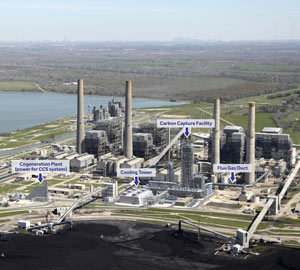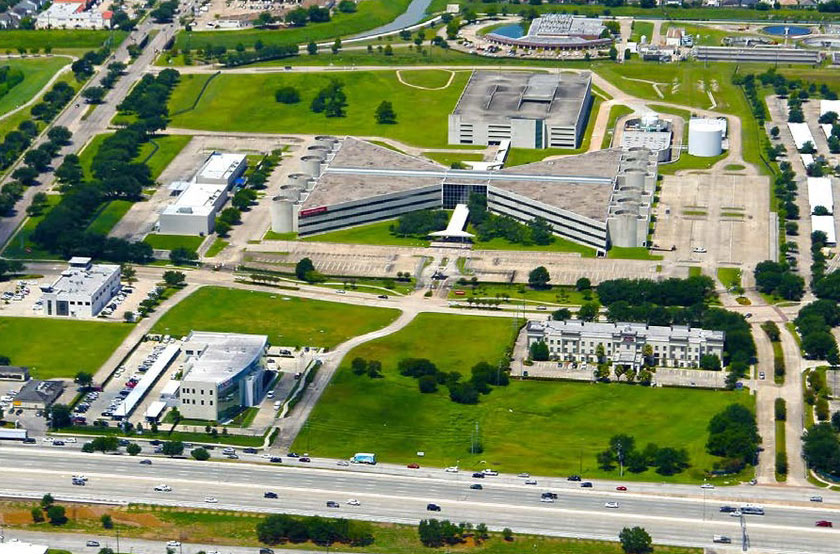W.A. PARISH COAL PLANT NOW RUNNING ‘CLEAN’ IN RICHMOND, HELPING BOOST OIL EMISSIONS FURTHER SOUTH  The years-long retrofitting of the W.A. Parish coal plant next to Smithers Lake in Richmond was capped off last week by a valve opening ceremony, at which the plant’s new Petra Nova carbon dioxide collection machinery was ceremonially turned on (though NRG says its been running since September). The new machinery is currently the largest such capture operation in the country, and might help knock the plant down a few notches from its recent high score on the carbon pollution rankings. Monica Simmons of the San Antonio Current, however, points out this week that whether the project actually results in a net reduction of CO2 emissions is something of a question mark: The project, which has been in the works since the over-$70-a-barrel days of 2010, is helping to pay for itself by piping that excess CO2 down to Jackson County and into the ground at the West Ranch oil field — which NRG says will help the folks there squeeze out 15,000 barrels of oil a day instead of 300. [San Antonio Current; previously on Swamplot] Photo of W.A. Parish Generating Station and labeled Petra Nova add-ons: NRG
The years-long retrofitting of the W.A. Parish coal plant next to Smithers Lake in Richmond was capped off last week by a valve opening ceremony, at which the plant’s new Petra Nova carbon dioxide collection machinery was ceremonially turned on (though NRG says its been running since September). The new machinery is currently the largest such capture operation in the country, and might help knock the plant down a few notches from its recent high score on the carbon pollution rankings. Monica Simmons of the San Antonio Current, however, points out this week that whether the project actually results in a net reduction of CO2 emissions is something of a question mark: The project, which has been in the works since the over-$70-a-barrel days of 2010, is helping to pay for itself by piping that excess CO2 down to Jackson County and into the ground at the West Ranch oil field — which NRG says will help the folks there squeeze out 15,000 barrels of oil a day instead of 300. [San Antonio Current; previously on Swamplot] Photo of W.A. Parish Generating Station and labeled Petra Nova add-ons: NRG





It goes to show how much complexity and cost is needed to support coal electricity generation with reduced pollution. Instead we could be ditching coal completely and moving to natural gas, wind, and solar. We could nearly halve our greenhouse gas pollution just by switching to natural gas. Already we see upwards of 10-20% of Texas electricity coming from wind and we have plenty of opportunity for more offshore wind in the Gulf and 24-hour CSP solar out west. We could easily rival countries like Denmark and Germany who are currently leading in renewables. They have done it through energy co-ops that let citizens invest in local renewable power generation, so they get a profit from turbines and panels in their own back yard. We could have the same if we loosened electric utility regulation. We just need imagination and long-term investment that looks beyond our 19th-century centralized, coal-coddling energy mindset.
This plant has emitted a stead stream of orange-yellow crap for the past 30 years…it’s easy to see from downtown Houston. A coal plant in oil and gas soaked Houston? …how much political hay got exchanged for that one??!!
There is no such thing as “Clean Coal”. It would be more accurate to say “Slightly Cleaner Coal”. HPM earlier reported “The Petra Nova system is able to divert about 40 percent of the CO2 that’s produced by one of the plant’s four carbon power units.” That would knock it from #5 to #10 on the list of worst-polluting plants – hardly “way down”. Something is better than nothing, but ultimately coal has to be replaced with gas and renewables.
No, this coal plant is not running “clean” at all. CO2 is just one of many emissions from a coal plant. Coal plants emit NOx and SO2, which form 03 (ozone) when they cook in the atmosphere. On particularly bad smog days, you can actually see localized smog form around this plant on the air quality monitor animations. Sequestering CO2 emissions helps reduce the emissions of greenhouse gasses, but does nothing to reduce smog.
Fair point, Skeptic! We’ve tweaked the language there.
@ Derek: The German situation is dissimilar to the United States, and it is no panacea of environmentalism. New renewables have mostly served to offset the closure of existing nuclear plants; it is their policy to retire their entire (quite large) nuclear fleet by 2022. Germany opted not to rely too much upon imports of Russian natural gas because it would put them in a difficult negotiating position and possibly compromise their national security situation. German electricity consumption is now declining, which makes perfectly good sense when you consider that residential customers now pay nearly $0.40/kWh. There is some reduction in coal-fired generation, but it mostly occurs during economic shocks and the capacity that gets retired is old inefficient legacy infrastructure. Some of it gets re-built. Coal is pretty much there to stay.
.
Circumstances in the U.S. are different, both domestically and internationally. We shouldn’t follow in their footsteps.
Derek- Lead the way. Shut off all of your electricity immediately.
Michael- What you’ve been seeing is mostly steam.
needs more nuclear, time to get real folks
I cringe every time I see a mention of how the Parish plant is a super large emitter of CO2. Of course it is, it’s a huge damn plant. I did an analysis in 2013 that compared large power plants in Texas for GHG emissions, and the Parish plant had far lower emissions per MW of capacity than any of the large plants:
Plant GHG MW GHG/MW
Parish 16,583,228 3,565 4,652
Martin Lake 18,701,286 2,230 8,386
Monticello 13,880,166 1,880 7,383
Limestone 13,066,969 1,706 7,659
Sam Seymour 11,289,000 1,690 6,680
Welsh 11,103,023 1,674 6,633
Big Brown 9,468,521 1,150 8,233
This latest update should make that number even lower.
@TheNiche: Yes, Germany replaced nuclear with renewables and did not replace much coal, but the point is they modernized their grid and electricity market to accommodate more renewables (now at around 30%). We could do the same and not worry about replacing nuclear and by transitioning with cheaper natural gas and not have to pay $0.40/kWh.
.
@Pffft: It’s funny that when someone says “hey, let’s use X instead of Y to generate power,” your reaction is, “well why not just stop using power?!”
Derek- You are the one that wants to ditch coal completely. Do it.
It says right in there that excess will be pumped into the ground in order to extract oil.
So it’s preventing CO2 from getting into the atmosphere by pumping it into the ground where it will help in extracting oil which will be used to throw that same CO2 and MORE back into the atmosphere.
This would be hilarious if it wasn’t putting every species on Earth at risk.
@ Derek: My point was not that it couldn’t be done, but rather that the comparison is weak. And even if it could be done at a lower cost than it has been done in Germany (which I think would be the case in much of the United States, although probably not all of it), saying that it would be ‘easier’ is not the same as saying that it would be ‘easy’.
.
If you consider what has happened in ERCOT (the grid that services most of Texas) over the same period of time that Germany has ramped-up its renewable energy investments…honestly, I think that what you find is a very regionally appropriate set of solutions. These entail lots and lots of wind generation, new transmission lines from wind-generating areas, and transmission/distribution upgrades in urban areas. Cheap natural gas has resulted in dozens (hundreds?) of new natural gas plants for when the wind stops blowing; and proposed new coal and nuclear plants that had been proposed prior to the fracking boom have been cancelled.